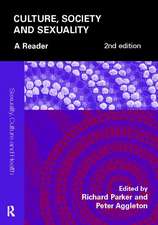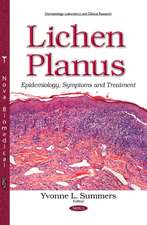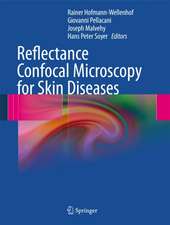Hair Research: Status and Future Aspects; Proceedings of the First International Congress on Hair Research, Hamburg, March 13th–16, 1979
Editat de C. E. Orfanos, W. Montagna, G. Stüttgenen Limba Engleză Paperback – 31 ian 2012
Preț: 1439.68 lei
Preț vechi: 1515.44 lei
-5% Nou
Puncte Express: 2160
Preț estimativ în valută:
275.48€ • 288.40$ • 227.94£
275.48€ • 288.40$ • 227.94£
Carte tipărită la comandă
Livrare economică 05-19 aprilie
Preluare comenzi: 021 569.72.76
Specificații
ISBN-13: 9783642816529
ISBN-10: 3642816525
Pagini: 740
Ilustrații: XX, 714 p.
Dimensiuni: 170 x 244 x 39 mm
Greutate: 1.16 kg
Ediția:Softcover reprint of the original 1st ed. 1981
Editura: Springer Berlin, Heidelberg
Colecția Springer
Locul publicării:Berlin, Heidelberg, Germany
ISBN-10: 3642816525
Pagini: 740
Ilustrații: XX, 714 p.
Dimensiuni: 170 x 244 x 39 mm
Greutate: 1.16 kg
Ediția:Softcover reprint of the original 1st ed. 1981
Editura: Springer Berlin, Heidelberg
Colecția Springer
Locul publicării:Berlin, Heidelberg, Germany
Public țintă
ResearchDescriere
Several years ago a friendly looking young man walked into my office at the University Department of Dermatology in Cologne, introduced himself as a diplomate chemist, executive member of a family-owned, rather small German company manufacturing hair care products, and proposed to me straight forward to organize an international meeting on hair research. In view of the large number of new developments in the field something like this should be done after all, he said; he also promised to provide financial support. Such a meeting should be on the highest possible level, I said; and he agreed. I took the challenge and my visitor kept his promise. Three years later the First International Hair Congress was organized at the sophisticated new Congress Center in Hamburg, in which 630 participants from 36 countries were registered. After three and a half days of formal sessions, informal discussions, workshops and poster presentations our unanimous feeling was that this has been a most successful meeting. The young chemist was right. The idea was excellent. The growth and presence of hair and its distribution over the human body as a cosmetic attribute has become during the last two decades a matter of tremendous emotional significance. Hair can be rather easily formed according to one's sence of style, representing his personal image and his social feeling. If it becomes unacceptable or out of fashion, the hair style can be easily changed; the hair regrows as a biological requisite, without any additional cost.
Cuprins
I Basic Research on Hair and the Hair Follicle.- Considerations on Hair Research and Hair Growth.- Ultrastructure of Developing Hair Tract and Hair Canal in the Human Fetus.- Intrafollicular Interactions.- Concentric Lamellar Bodies in Normal Dermal Papilla Cells During Anagen.- Hair Follicle Transglutaminases and the Formation of ?-(?-Glutamyl) Cross-links.- Enzymes in Human Hair Sheat Cells — A New Means of Characterizing Hair.- Something Old: Blood Vessels, Nerves, and Hairs.- Cytochemistry of Merkel Cell-neurite Complex in Mouse Sinus Hair Follicles.- Morphology and Fine Structure of Hair.- The Hair Surface.- Characterization of Hair Keratins.- The Proteins of Normal and Aberrant Hair Keratins.- Ribonucleic Acids Coding for the Keratin Complex of Hair.- Enzymatic Digestion of Hair Components.- The Binding of Small Molecules and Polymers to Keratin and Their Effects on the Physicochemical and Surface Properties of Hair Fibres.- Action of Nucleophilic Reagents on Hair Keratin.- The Synthesis of Nonfibrous Proteins in Newborn Rat Hair Follicles.- Elemental Ratios Along Partially Gray Human Hair.- Studies on Trace Elements in Human Hair by X-ray Emission Spectroscopy.- Factors Influencing Elemental Composition of Human Hair.- The Isolation of Melanin From Hair.- Human Hair Pigment: A Mild Isolation Procedure and a Method for Characterization.- Hair Melanin and Hair Color.- Green Hairs: Elementary X-ray Analysis in the Electron Microscope.- Hair Follicles and Their Environment.- The Environment of the Hair Follicles.- Environmental Influences on the Hair Follicle.- Hormonal Control of Hair Growth.- Mechanisms of Androgen-mediated Hair Growth.- Androgen Metabolism in Isolated Human Hair Roots.- The Metabolism of Androgens in Skin.- Hormones and the Pilosebaceous Apparatus.- Local Factors Affecting Rodent Hair Cycles.- II Clinical Research and Therapy.- Alterations of the Hair Follicle in Hair Diseases.- Cellular and Chemical Changes of Dermis Accompanying Physiologic and Pathologic Hair-changes.- Effect of Undernutrition Upon Hair Growth.- Nutrition and Hair Anomalies.- Hair Growth in Disorders of Metabolism.- Cellular Activity in the Adventitial Dermis of Inflammatory Alopecias.- An Objective Approach of the Diagnosis of Diffuse Alopecia: The Trichogram.- Hormone-induced Disorders of Hair Growth.- Alopecia Androgenetica — Its Incidence in Japanese and Associated Conditions.- Comparative Studies of the Diameters of Hairshafts in Anagen and in Telogen Phases in Male Adults Without Alopecia and in Male Adults with Androgenetic Alopecia.- Alopecia Areata — Modern Aspects.- Antibodies in Alopecia Areata.- Aspects of Endocrinological Treatment of Hair Diseases.- Estrogen Treatment of Hair Diseases.- Antiandrogens — Scientific and Experimental Background.- Antiandrogens — Basic Concepts for Treatment.- PUVA — Therapy for Alopecia Areata.- Treatment of Alopecia Areata with Phenolum Liquefactum Caustic Process and Stimultaneous Belladonna Dose.- Comparison of DNCB and Croton Oil in the Therapy of Alopecia Areata.- Hair Neogenesis in Man: A Histoquantitative Study Based on 1,000 Scalp Biopsies.- Sebaceous Glands of the Scalp. Variations in the Synthesis of Nucleic Acids in Male Pattern Alopecia and Alopecia Areata.- Hair Surface Lipids in Psoriasis Vulgaris.- Alopecia in Hypothyroidism.- Prevalence of Thyroid Abnormality Associated with Hair Loss.- Hair Follicle Tumors.- Hair Follicle Tumors in a Case of Multiple Hamartoma Syndrome (MHS).- Trichofolliculoma and Trichoblastic Fibroma.- Light and Electron Microscopic Studies of Steatocystoma Multiplex.- Colour of Hair and Colour of Iris Within the Atopic Syndrome.- Traction Alopecia Due to Traditional Hair Styles.- Etiology of Hair Disease in Eastern Anatolia.- Abrupt Hair Loss Following Severe Psychological Stress.- Hypotrichosis and Alopecia in Cases of Genodermatoses.- Weathering of Hair in Hereditary Hair Abnormalities.- Polarized Light Microscopy. Its Interest in the Study of Congenital Hair Defects.- Curly Hair as Presenting Symptom in Giant Axonal Neuropathy.- Crimped “Spun-glass” Hair in Siblings: With Twelve Year Follow-up of an Earlier Case.- Bjørnstad Syndrome (Pili Torti with Deafness): Clinical, Genetic, and Ultrastructural Findings.- Scanning Electron Microscopic Investigations of the Hair in Ectodermal Dysplasia Syndromes.- Amino Acid Content of Damaged Human Hair.- Abnormal Amino Acid Changes in Human Hair Associated with Rare Congenital Syndromes.- Scanning Electron Microscopy of Hairs in Comedones.- The Significance of Mean Scale Number of the Cuticular Scale Pattern as a Means of Identification in Mammalian Hair.- The Role of Hair in Forensic Investigations.- Drug Induced Alopecia.- III Hair Care Products and Hair Transplantation Techniques.- Introduction: Human Hair and Scalp in View of the Use of Hair Care Products.- The Reactivity of Human Hair. A Review.- The Role of Hair Care Products.- The Side Effects of Hair Products on the Scalp and Hair.- Recent Developments in Hair Care Products.- The Use of Scanning-electron Microscopy to Assess Damage of Hair.- Hair Dye Toxicity.- Some Skin Problems Due to Hair Preparations.- Clinical Reactions to Hair Products.- Unfavourable Effects on the Epidermis of Some Common Ingredients in Every Day Shampoos.- Effects of Hair Care Products on Sebaceous Gland Secretion.- A Technique for the Quantitative Evaluation of Regreasing of Individual Hairs in vivo After Shampoo Application.- Toxicology Profile of the Antimicrobial Zinc Bis 1-Hydroxy-2-(lH-Pyridinethionate).- Dandruff: Etiopathogenesis and Histopathology.- Characterisation of Dandruff by Means of Cellbiologic Parameters.- Effect of Hair Care Products on Dandruff.- Detergent Scrub Method: A Useful Assay for Control of Antidandruff Preparations.- Studies on the Effect of Shampoos on Scalp Lipids and Bacteria.- Methods for Testing the Hair and Scalp.- Contributions to the Elastic Behaviour of Hair Fibres and Hair Strands.- The Buffering Capacity of Various Kinds of Hair Measured in vitro.- Precise Measurement of Humidity Effects on Human Scalp Hair Diameter.- The Radiometric Technique. Explained by the Example of Adsorption and Desorption of 14C-labelled Distearyl-Dimethylammonium Chloride on Human Hair.- The Problems of Hair Transplantation.- Particular Techniques of Hair Transplantation.- Technical Problems in the Treatment of the Male Pattern Baldness, Scalp Rotation Flap.- The Scalp Lift, an Adjunct to Hair Transplantation in Androgenetic Alopecia.- The Treatment of Baldness by Hair Transplant, an Experience of 7000 Operations by Multiple Punch Scalp Grafting.- Hair Transplantation in Cicatricial Alopecias.- New Instruments for Hair Transplantation.- Genetics and Androgens in “Male Pattern” Alopecia. Physiopathologie Bases of Hair Graft.- Treatment of Effluvium Capillitii with Collagen CLR and Placenta Extract Containing Preparations.- The Psychosomatic Effects of Alopecia.













